We reached the end of a long, winding road that snaked through a tiny Japanese village in Kawatana, infamous for being the site of a kaiten (回天) training school. Kaiten are the manned suicide torpedoes used by the Japanese Navy during WWII to take out enemy vessels.
The Kawatana Torpedo Boat Training School (川棚魚雷試験場跡地) was established in 1944 in response to Japan’s ever-worsening situation in the Pacific War. The school was used to train young men as torpedo pilots who volunteered themselves for the cause. In addition to the torpedo pilots, other squadrons from the Japanese Special Attack Units were also trained here, including Shinyo (suicide boats), midget submarines and, although never used, the Fukuryu (suicide frogmen), who would make stealth attacks from under the water. Kamikaze pilots were trained at the nearby Tachiarai base.
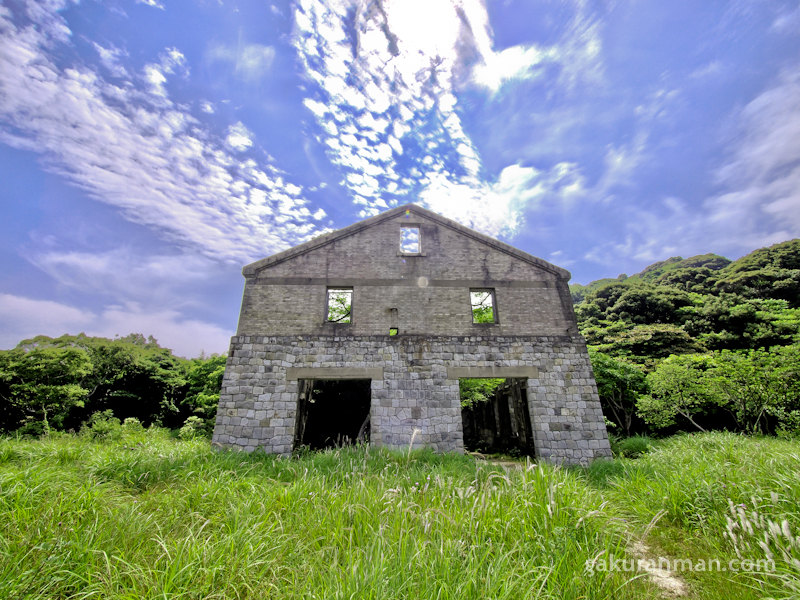
Ikumi pulled up the car by the sea and looked over.
“Not a great deal of time for this place. We need to be back at the airport in a few hours.”
“Gottit” I replied. “It’s not huge anyway, and it’s a public place, so it’ll be easy to shoot. I just hope there are no cosplayers blocking our shots!”
I could feel the soft dirt of the track under my feet as I followed her towards the main factory warehouse. Squinting in bright morning sun, I looked up at the looming structure. To its right, a large rectangular area sunken into the earth, most likely used for testing the buoyancy of torpedoes.
The main factory was just an empty shell of what it once was. Now you might even call it picturesque, nestled lovingly amongst the tall grasses surrounding it, but 66 years ago, it must have been a bustling hive blanketed in tension.
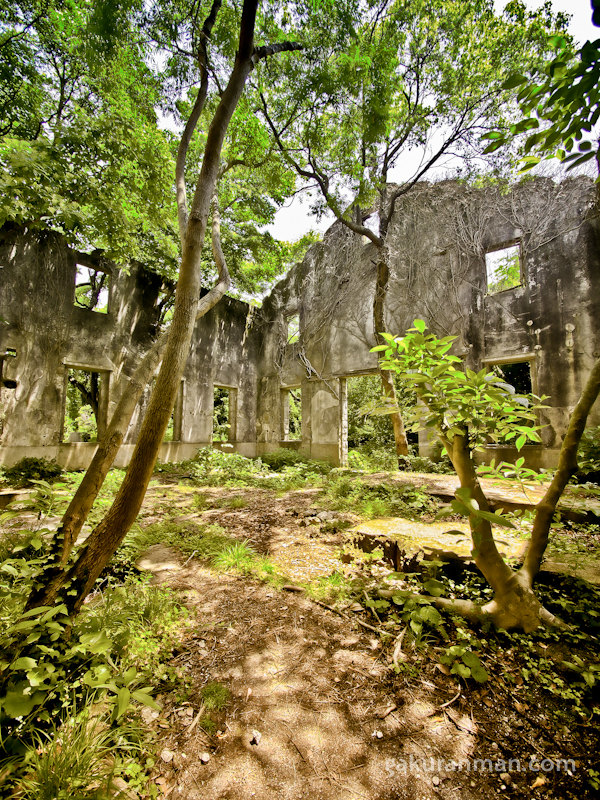
As we walked in, I couldn’t help but imagine where different things used to lay. Where was the machinery? Why was a hole cut out that way in the floor? Wherever stuff used to be, now it was gone and the only thing remaining was the sheet of white tiles covering the floor. New trees had sprouted, vines clung to the walls and the ominous hole in the floor was filled with a turbid water, home to dozens of colourful red crabs.
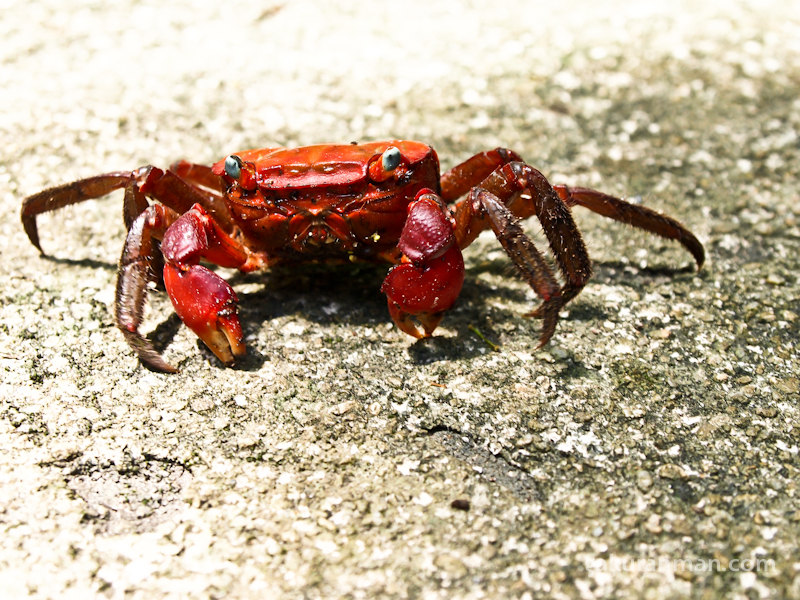
“Look here!” I shouted.
Ikumi turned in surprise, clutching her camera and oversized wide lens.
“Right there, in the pond!” I pointed, grinning childishly. “This place is full of crabs! And huge ones at that!”
Most normal people would have been baffled at my crazed excitement, but a slow smile crept across Ikumi’s face as she lowered herself down for a better look.
“Let’s catch one!” she chirped.
I was already poking away with a stick, trying to hook one of the big ones from the sludge.
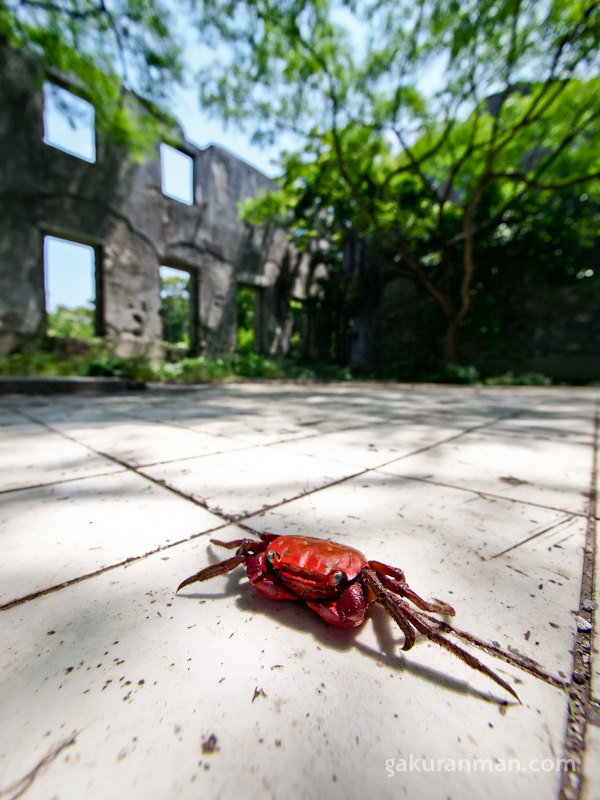
It wasn’t easy though. The water was deep enough for the crabs to slip away, but after some effort, I grabbed one.
“Argh! The damn thing tried to pinch me!”
“How the hell are we supposed to catch these things when they can reach under themselves to nip you?”
“Ohhh, you have to catch it at the sides. Their claws don’t reach in that direction” Ikumi replied, stifling a laugh.
All thought of the ominous factory had completely vanished by now. 66 years past; all the history and notoriety of this location replaced with a juvenile wonder and a basic course in crab-catching.
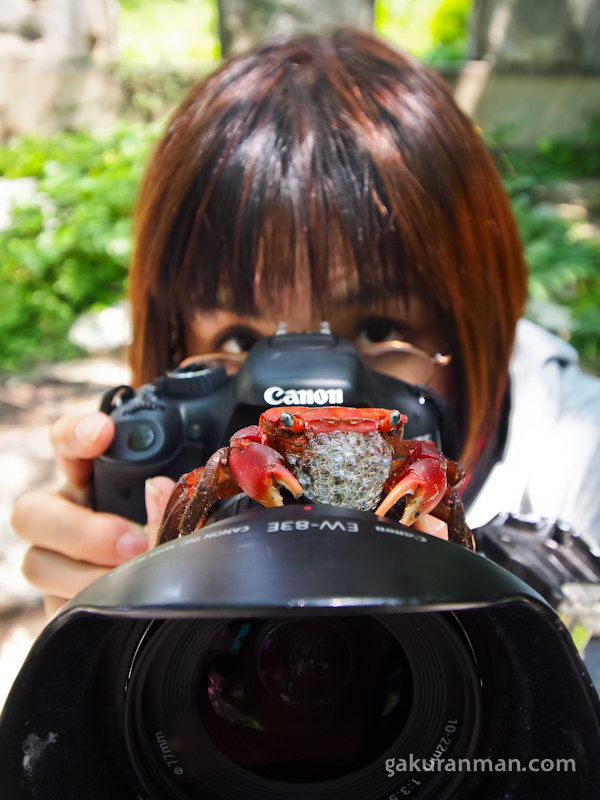
After a while, we captured the biggest dude in the pond. He first he wouldn’t stay still for a photo, but eventually seemed to tire, allowing us to sit him on top of the camera lens for some interesting shots. Shockingly, however, he started foaming at the mouth! I’ve never seen crabs produce bubbles like this and at the time I wondered if he weren’t angry or if it was a kind of defence mechanism.
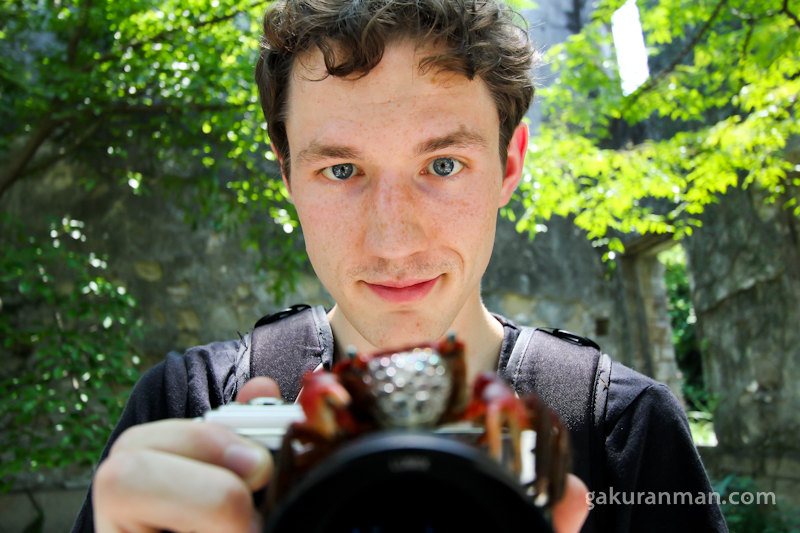
It turns out that actually, it is, sort of. Crabs blow bubbles when they are dehydrated in order to aerate their gills and keep them moist. We’d kept this little critter out the water for so long that he’d begun to heat up and suffocate! Geese, now I feel really bad. He seems like a warrior though – the right claw was snapped, perhaps from a fight! (Ikumi shot the great photo of me and my E-P1 above! She’ll have her own website up soon, so I’ll update this with a link when that happens :) ).
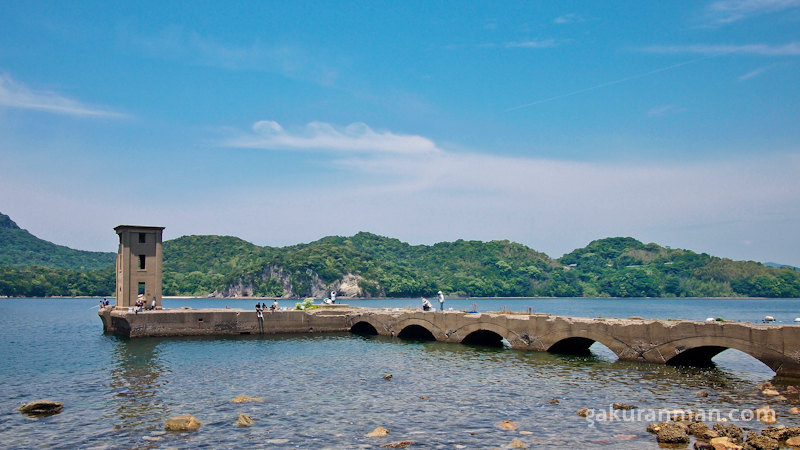
After shooting, we placed him back in the pond to cool off. A whole hour had passed and we were quickly approaching our time limit. Hopping back outside the main factory, I continued down the dusty path alone while Ikumi took photographs in a different area.
One of the main towers used to launch torpedoes was positioned at the end of a walkway a little out at sea. The second tower has been destroyed over the years. Today it was full of people enjoying the beautiful weather – old guys fishing, kids splashing about in the sea and couples sitting and relaxing. I wondered if they appreciated the significance of the site and snapped a quick photo. They weren’t happy about being in shots, so I moved on to the final structure.
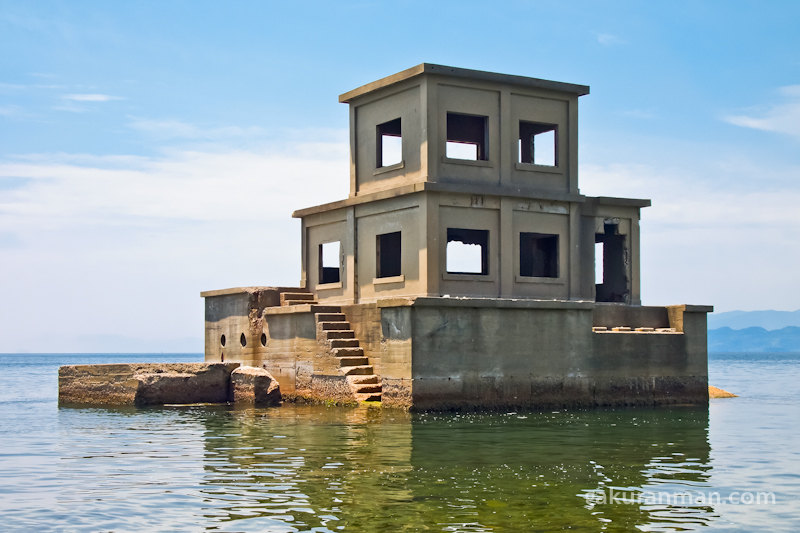
This is the lookout post, resting alone in the water. The concrete path connecting it has since crumbled and eroded away and it sits, quite majestically, against the backdrop of a clear horizon under a dusky sunlight filtering down. The light was wonderful for photographing this structure, but I imagine it would look great in any situation. It seems to have an aura about it. Something a little sacred.
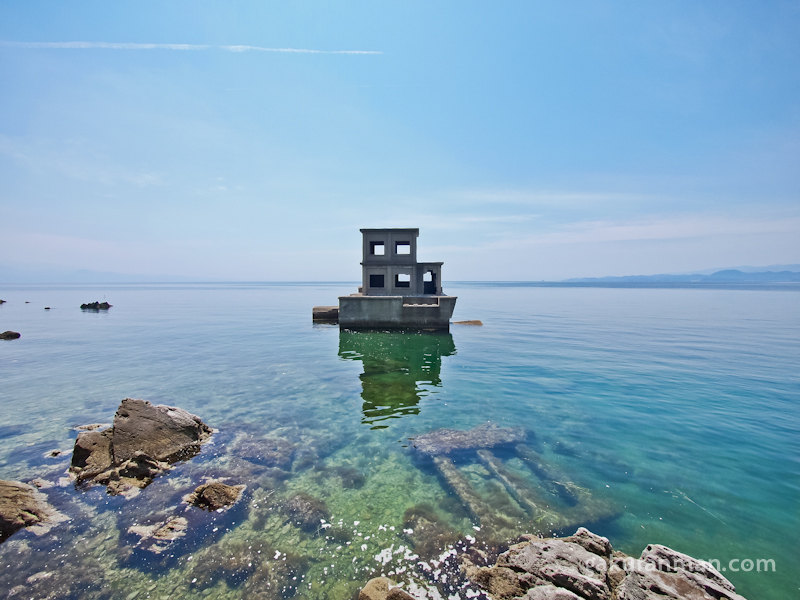
Here’s an artistic shot I attempted below. I deliberately shot the structure out of focus to enhance the shapes of the windows against the sky and tweaked the settings after making it black and white. It gives quite an eerie impression of the place, I think. Much closer to the dark past it conceals.
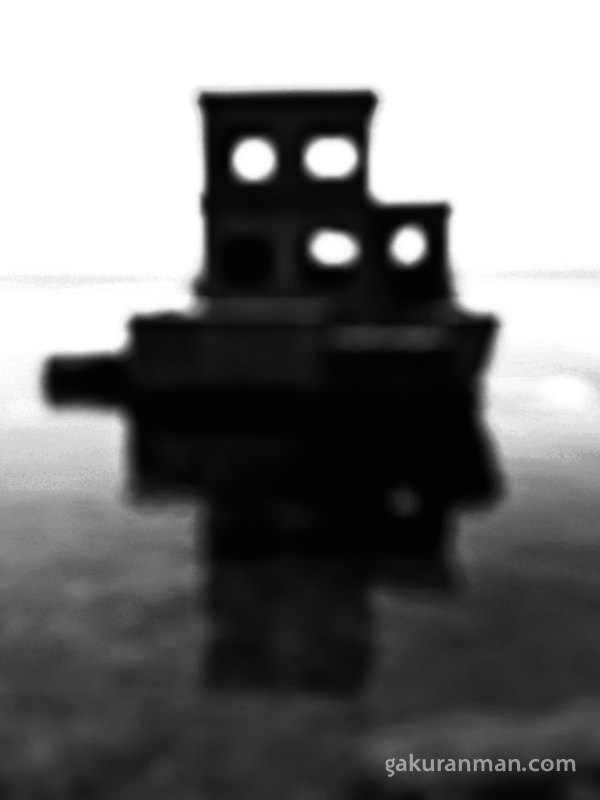
Just before getting back in the car to head back to the airport, Ikumi and I called back into the factory for a final shot or two. It had been a fun day and great weather, but time to leave Nagasaki and go home. Unbeknownst to me at the time, way up on the hill above the 3 structures was a torpedo watchtower overlooking the area. There’s nothing of interest inside, apparently, but it kind of completes the set. I’d like to come back in Winter to see this place covered in snow and maybe even swim out to that lonely lookout post.
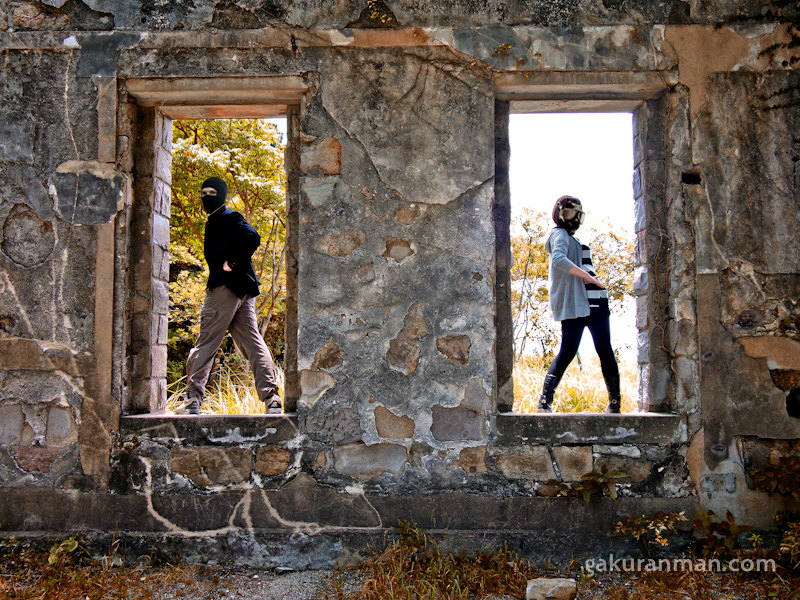
Well, just two more haikyo to go in the Nagasaki set! I can’t believe it’s been nearly 4 months since we went there! Next up though, I want to interrupt it with a re-visit to the fascinating Secret Doctor’s Shack. I made a couple of shocking new discoveries! Keep an eye out for that soon :).









I’m not sure if you’re still on this blog but there’s a Navy base close by in Hario where I live on base. I go out to this building so much because the military families LOVE having their family sessions done there. I absolutely love the history of this building and I’m so glad to see more information on it. My family and I have treked to the top of the mountain for fun and enjoyed the view but nothing compares to the one lone, largest building at the bottom of the mountain. Unfortunately, recently somehow a big tree sits dead on its’ side in the back of the building. I’ve NO idea how it got there. Nothing is uprooted in the back nor is the building itself damaged from a potential tree falling over. It just takes away more from the somewhat majestic style of it and leaves less room to work with families in the back.
Ikumi is fit
These photos are the best I have seen of this particular haikyo by anyone so far. If you had Color Efex Pro 3 the polarizing filter in there would bring out the blues even more and if you used the selection tool in Photoshop to selectively adjust the contrast on just the water that would make them pop even more.
The shot of the building out of focus reminds me of the famous Loch Ness Monster photo! I like the thinking. Got to think out of the box when any number of people have already been there shooting the same place. As I always tell people, a photograph should show me something I cannot see just by standing there at eye level. The out of focus shot is something I cannot see just by standing there, therefore it makes the photograph interesting and not just some mugshot of something.
Are you really wearing that headgear while in the haikyo, or do you put it on only for that shot?
Cheers man. I usually do use CE3 after you recommended it. I didn’t use the polarising filter this time though and neither did I try selective contrast on the water. Maybe I’ll have a play again tonight :)
Thanks for the comments in the arty shot. It didn’t come out quite as I had envisioned it, but it was fun to edit nonetheless. Next time I’d like to try shooting from under the water looking up at the structures. I don’t think anyone has done that yet!
As for the headgear, that was actually added in post processing! This place is pretty public, but Ikumi preferred to keep an air of enigma about her. My headgear was just to keep the feel – one person with headgear seemed odd.
Agreed, one person with headgear would have been odd.
Still shooting in JPG too?
Let me know if you do anymore selective contrast on the above shots.
Haha, yes, still in Jpeg :P. Haven’t found it to be a limitation for me yet, or perhaps it’s a case of not knowing the improvements that could be had with Raw. They do say that on the E-P1, Jpeg output is extremely close to the Raw, so I’m not sure it would be worth the extra effort to get the Olympus colours back and time spent converting files.
That RAW is somehow more difficult to work with or edit is a myth, that I once believed myself for a long time. I use Aperture 3 and working with RAW files in it is exactly the same as working with a JPG.
–> put memory card into 24″ Dell monitor’s built-in card reader
–> files nearly instantly appear in Aperture 3
–> set custom filename and comprehensive metadata tagging on import
–> import files, approximately 400 RAW files can be downloaded in about 3 minutes, which are then ready to be edited. The automatic processing Aperture 3 does (based on a specific profile for your exact camera) takes about 12 minutes for all to be said and done, but you can start working on a file after just a minute really.) Of course this varies by CPU and other computer speed factors.
I of course don’t keep 400 hard drive hogging RAW files around. Depending on the type of shooting I did (for a wedding, portrait, event client) or just personal shooting, I save maybe 20-200 JPGs for the archives, and delete all the RAWs. Thus no extra space taken up, no extra work upon import, dismissing the two major concerns about RAW.
I see. How do you batch process and save 200 Raw files without editing each individual picture? That for me is the biggest problem. I go through and delete pictures I don’t want which takes up a lot of time already, so the idea of having to correct pictures one-by-one is what turns me off.I actually did a little experimenting with Raw the other day though. For the E-P1, Lightroom appears to have a profile, but the colours are slightly different to what the camera renders its Jpegs as. I’ve heard of theses differences appearing before between the Olympus Jpeg engine and a 3rd party converter. Of course, i probably could just buy the official Olympus software to convert the pictures to their correct colours and then bring them into Lighroom, but it’s another added step and frustration…I did note some very interesting results between the Raws and Jpegs when editing however. For well-exposed pictures, I could get very little noticeable difference between the two formats. I tried knocking the exposure compensation up fully and then using Lightroom’s ‘Recovery’ option to pull back the highlights. Raw had a little more headroom (hence those pictures turned out brighter than the Jpegs at the same settings). I then tried to sharpen the images and used luminance noise adjustments and masking to control the smoothness of the images. Even when I applied 100% luminance smoothing, here there was again very little difference between the two types (and in fact, the Jpegs turned out to be better looking pictures to me because they retained the original Olympus colours from the in-camera processing).However (and it’s a big however!), when I did the same thing with horribly underexposed pictures (I’m talking dark foreground, properly exposed sky), the Raws suddenly showed me what they could do. It was no competition. Doing the same things I talked about above, it was noticeable early on in the exposure adjustments and using the Recovery option that the Raws had retained a lot more detail in the shadows than the Jpegs. I could even make out some crisp letters on signs! Moving onto the sharpening, again, the Jpegs failed horribly. After sharpening, at full luminance smoothing the level of detail retained was readily apparent. The Jpegs were a horrible smush of colour, and the Raws kept an acceptable level of detail that would be useable in a pinch.Basically then, for normal, well-exposed images, the Jpegs seem to be fine (unless I want to put in the extra effort to get those beautiful Olympus colours back – might have a think on this). For heavily underexposed images, Raw is without a doubt much, much better. But I wonder what sort of situations will cause me to heavily underexpose? Perhaps when shooting with skies in the background it may be better to use Raw so that I can lighten the foreground and retain more detail. Up until now I’ve avoided this problem by HDR-ing such shots (which I imagine will still be necessary for extreme differences between the sky and the foreground).So I wonder – any advice for keeping those Olympus colours? If I can sort that out, I imagine I can use Raw initially, save most of the files as Jpegs immediately and just concentrate on the tough images with blown highlights or heavily exposure contrasts. That way I’ll avoid most of the work and keep the extra detail in the darker shots. I’ve still been very happy with the properly exposed Jpegs though – it seems that there is some truth to the claims that Olympus has the best in the industry :).
Aperture 3 does do a batch process on each photo upon import. I then go through each photo and fine tune the adjustments in Aperture, do more stuff (the key stuff) in Color Efex Pro 3, then any heavy lifting in PS CS5. I first go through all 400+ shots and rate them and delete the obvious fails. Then I choose to display only 4 or 5 star images and edit the best ones from there. After I finish a project, I then delete everything I will not deliver to the client or keep for my own portfolio.
How colors look on screen is dependent on many things. What kind of monitor are you using? What percent of the color gamut can it display? (if not at least 92% then you are not really seeing enough color IMO). Has the monitor been calibrated at all recently? What is the ambient light in the room? Is your monitor the brightest source of light? (it should be)
How will those colors look when editing at night with the lights on?
I am not sure what you have your Olympus set to, is it perhaps set to some vivid default setting? I have my D300 set to Standard.
I trust Aperture (or Bridge, or Lightroom) to process RAW images better than I do a camera’s JPG processing.
I mean, for putting up 600-800px wide shots onto a blog, one does not need to sweat things so much for sure. And if it feels like a hassle or takes away time you could otherwise be shooting or going to another haikyo, then that would be a negative also. You do not have to deliver high resolution images to a paying client, so JPG is fine most of the time as your own experiments showed you.
All I know is every other pro in the world shoots in RAW (save maybe sports photographers), so I do too. I trust that they are right.
Very interesting to see your shots- they`re much brighter ad bluer than what I had. I guess when I was there it was just before getting dark, and while I got a few shots with blue skies in, I mostly got cloudy skies. That turned out to be quite dramatic- so how different it is to see this place all brightly lit up. It almost looks happy!
Nice use of the crab to add variety too. I had no idea about the bubble trait either. The final shot though, you and the girl, I thought you had your hand on your hip holding up your jacket tails up so as to show off your (ahem) assets. I would have let that one slide…
Haha, now that you mention it! I didn’t even notice o.O; Oh well. Eyes probably aren’t on my anyway!
Yea, looking at your gorgeous dusky shots during sunset makes me want to go back. This is definitely a place that would change its character depending on the weather :).
Altough one of the most photographed abandoned places in Japan in my opinion it’s one of the most underrated. There is barely anything left to see, but it’s such a unique location with such an important history! I’d go there again at any time, too. (And like you said: It’s very relaxing to shoot as it’s kind of a public place.) The crabs are a nice spin! Of course they weren’t there in March – but it looks like summer haikyo is not always bad…
Hey Florian! Thanks for dropping by. Kawatana was a bit of a mystery for me. I had already seen the photos on MJG and Tokyo Times and, while looking unique, didn’t seem to be a ‘must-see’ location at first. But considering the history, the beauty of those isolated structures, and of course the pool of crabs, it made for a great exploration! I think when I went it was still just before mosquito season too, so much more relaxing :).
Hi, Mike, long time no see. I enjoyed your photos and writing.
I would like to tell one more site of Human torpedo training school.
Actually, my hometown used to be one of the biggest training centres in Japan, which is located in Shunan-shi, Yamaguchi.
There is a museum about human torpedo and also training bases in the sea. A few years ago, one film was made called ‘出口のない海’ leading actor was 市川海老蔵. As you know the surrounding area of Seto Inland Sea such as Hiroshima, Yamaguchi used be a big military based site,
So, if you are interested in the history of desparate suiside attacks such as Human Torpedo, Divine Wind, and so on, you might find other sites or ruins as well.
For reference, check this website. http://www.city.shunan.lg.jp/section/ed-sports/ed-shogai-bunka/kaiten/index.jsp
Hope you are interested in…
Long time no speak! Thanks for the link Nana. I saw some of these pictures when I was browsing around for information on the kaiten, so it’s good to confirm where it is. I’ll be sure to check it out next time I’m out in that area!
I went to he Kaiten base in Shunan recently and really enjoyed it (I cried lots too). Recommended. Very attractive place highlights the sadness of the story.
Your photos make the dilapidation gorgeous. Very nice.
Cheers Brian :)